
The Clube Juvenil headquarters are located in the Brazilian city of Caxias do Sul, in the state of Rio Grande do Sul. It was built in 1928 and listed as a municipal heritage site in 2007. [1]

The Clube Juvenil headquarters are located in the Brazilian city of Caxias do Sul, in the state of Rio Grande do Sul. It was built in 1928 and listed as a municipal heritage site in 2007. [1]
Clube Juvenil is one of the most traditional recreational associations in Caxias do Sul. It was founded on June 19, 1905, by Carlos Giesen, Henrique Moro and Américo Ribeiro Mendes under the name Club Juvenil. The festive inauguration took place on July 23, 1905, and the first gala ball was held on December 31. The association's first headquarters were based in José Bragatti's townhouse. [2] [3]
In 1912, the first proper building was inaugurated. It consisted of a wooden and masonry house in Andrade Pinto Street, now Os 18 do Forte Street, which operated until 1924, when a fire destroyed it. Construction began on a new venue under the design of Silvio Toigo. Until the closing of the clubhouse in 2019, it regularly held cultural events for the local community, such as art exhibitions, concerts and literary soirees, besides its exclusive social and recreational activities for members. [4] [5] [6] [1]
The building was designed by Silvio Toigo and inaugurated on September 8, 1928, with two floors and a basement. The third floor was built between 1962 and 1965. In 1990, the exterior of the building was restored and painted. In 2001, the Intermediate Hall underwent renovations to restore the space. Known as the Golden Hall, its location on the second floor offers access to the Hall of Honor, which features a gallery of photos of the club's founders and presidents, and the Queens' Gallery. The interior contains several rooms and halls reserved for various uses. The basement housed a restaurant, the collection rooms and the Pelourinho nightclub. On the first floor, there was a bombonière, a secretariat and rooms for recreational games. On the upper floors, there were two large party rooms, one seating 200 people and the other 400. On December 12, 2007, the historic building was listed as a landmark site by the Caxias do Sul City Hall. [5] [1]
In 2019, the building was closed to the public and its activities were suspended. The restaurant was closed and the building was put up for rent in 2021. The administration claimed to be unable to afford the maintenance of the building and hoped that the rental income would help solve the problems. [7] [8]

Sociedade Esportiva e Recreativa Caxias do Sul, commonly known as Caxias, is a Brazilian professional association football club based in Caxias do Sul, Rio Grande do Sul. The team plays in Série C, the third tier of the Brazilian football league system, as well as in the Gauchão Série A, the top tier of the Rio Grande do Sul state football league.

Esporte Clube Cruzeiro, commonly referred to as Cruzeiro-RS, is a Brazilian football club based in Cachoeirinha, Rio Grande do Sul. It currently plays in Campeonato Gaúcho Série A2, the second level of the Rio Grande do Sul state football league.

Events in the year 1972 in Brazil.

Anderson Daronco is an association football referee. He has worked as a referee in the Campeonato Gaúcho, the Copa do Nordeste, Campeonato Brasileiro and the Copa do Brasil.

The Municipal Museum of Caxias do Sul is a Brazilian historical, artistic, and ethnographic museum, located at 586 Visconde de Pelotas Street, in Caxias do Sul, in the state of Rio Grande do Sul.

The Historic Center of Caxias do Sul is a Special Sector of the city contemplated in its General Plan and regulated by specific legislation. It comprises the region that was first urbanized, located around the Dante Alighieri square and limited by the streets Os 18 do Forte, Bento Gonçalves, Alfredo Chaves, and Moreira César. The Historic Center has been the vital core of Caxias do Sul since its origin and has undergone profound changes since the early days, but it still preserves its original urban layout and a number of buildings of great architectural and historical interest. However, it has suffered from frequent traffic jams and the degradation of some stretches.
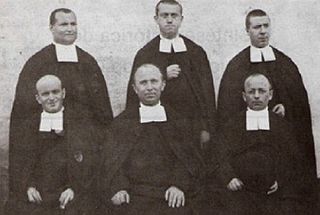
The Colégio La Salle Carmo is a secondary school in downtown Caxias do Sul, Rio Grande do Sul, Brazil. It is run by the De La Salle Brothers of the La Salle Brazil-Chile Province. It is one of the oldest private schools in Caxias.

The João Spadari Adami Municipal Historical Archive is a cultural institution in Caxias do Sul, Brazil. It has a large collection of documents, photographs, films, recordings, newspapers, and other materials, mostly related to the Italian colonization in the region and to the history of Caxias do Sul, whose value and extent place the institution as an important reference in the state.

Júlio de Castilhos Avenue is the oldest street in the Brazilian city of Caxias do Sul. Its route incorporated an old indigenous path, and until the first decades of the 20th century, it was nothing more than an unpaved road, even though it was the city's main street from the beginning. Later, it was extended, urbanized and ornamented, remaining with a straight line, with the exception of its end. Its current limits are the Getúlio Vargas Square, in front of the National Monument to the Immigrant, to the east, in Petrópolis neighborhood, and the junction with Rubem Bento Alves Avenue, to the west, in Cinquentenário neighborhood. Its evolution is intertwined with the history of Caxias, whose urban center remains as the main point of the city, and still holds several architectural examples of interest.

Dante Alighieri Square is the oldest and most traditional public square in Caxias do Sul, Rio Grande do Sul, Brazil, located in the center of the city. It was included in the colony's floor plan from the beginning of the territory's occupation and was the stage for many important events, having in its surroundings several historical buildings of great importance.

The Eberle Palace is a historic building in Caxias do Sul, Brazil, located at 1540 Sinimbu Street. It was the residence of the important industrialist Abramo Eberle, and is protected by the City Hall.
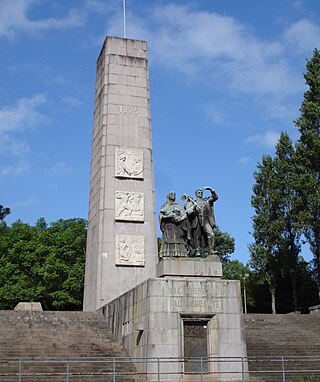
The Monumento Nacional ao Imigrante is a monument in Caxias do Sul, Brazil, located at the entrance of the city, on BR-116. It is listed by the National Historic and Artistic Heritage Institute (IPHAN).
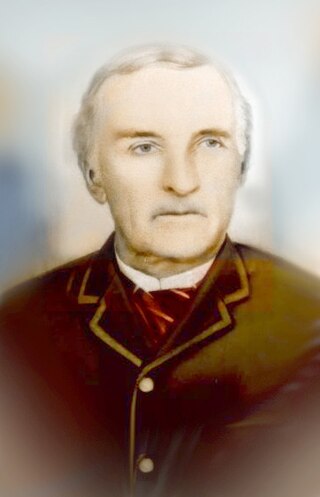
Salvatore Sartori, known in Brazil as Salvador Sartori was an Italian politician and merchant who became a naturalized Brazilian.
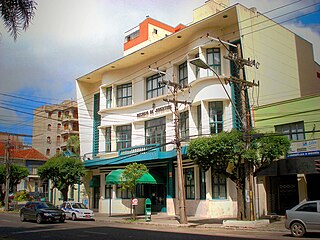
Recreio da Juventude is a club in the Brazilian city of Caxias do Sul. Founded in 1912, it is one of the oldest and most traditional clubs in the city. It has engaged in intense social, cultural, recreational, and sports activities since its foundation; the Esporte Clube Juventude branched out from the club. Currently, the Recreio da Juventude has a social headquarters, a large countryside headquarters with sports and leisure equipment, and remains the owner of the building of the old Central Cinema, which although deactivated since 1990, was one of the main show houses in Caxias, offering cinema, theater, and music. It won several titles in sports and the Central Cinema and the social headquarters building are listed as a heritage site.
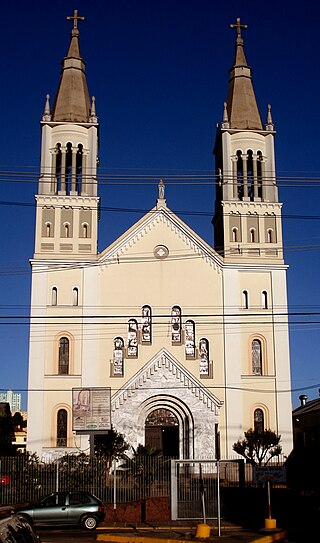
The Church of Our Lady of Lourdes is a Catholic temple located in the Brazilian city of Caxias do Sul, in Rio Grande do Sul. The Parish of Our Lady of Lourdes was created on February 8, 1942, by decree of Bishop José Barea. It was the first parish to be separated from the Parish of Saint Theresa, which was the only one in the urban area of Caxias do Sul until 1942. Father Maximiliano Franzoi was appointed its first parish priest in the same ceremony. Upon its creation, the Parish of Our Lady of Lourdes extended over a large area that was still only partially urbanized.
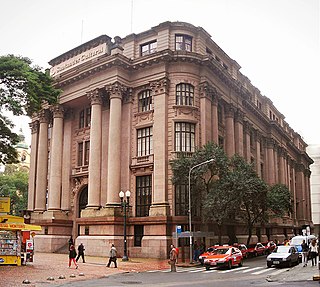
Farol Santander Porto Alegre, formerly known as Santander Cultural, is a Brazilian cultural center run by Banco Santander. It is located in a historic building in Alfândega Square, in the Brazilian city of Porto Alegre, in Rio Grande do Sul. It has been listed as a heritage site by IPHAE.
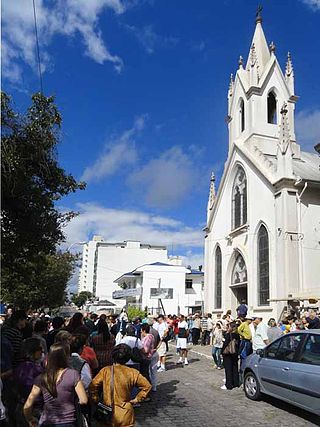
The Chapel of the Holy Sepulchre is a Catholic temple located in the Brazilian city of Caxias do Sul, in Rio Grande do Sul. It has neo-Gothic features and houses several works of art inside, including statuary by Michelangelo Zambelli, a mural painting by Aldo Locatelli and a crypt with a wooden sculptural group carved by Benvenuto Conte depicting the scene of the lamentation of the Dead Christ. It is listed as a heritage site by the City Council.
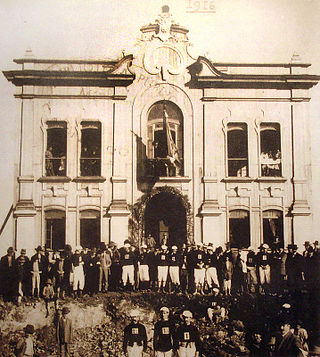
The Clube Juvenil is based in the Brazilian city of Caxias do Sul, in the state of Rio Grande do Sul. Founded in 1905, it is one of the oldest and most traditional social and recreational organizations in the city. It created the first adult soccer team and the first cinema in Caxias do Sul. In 2021, the headquarters were closed and the building was made available for rent.

The Old Sanctuary of Our Lady of Caravaggio, also known as the Old Mother Church or the Chapel of Ex-Votos, is located inside the current Sanctuary of Our Lady of Caravaggio, in the Brazilian city of Farroupilha, in the state of Rio Grande do Sul. It was the center of devotion to Our Lady of Caravaggio in the state until the 1960s. In 2006, it was declared a state heritage site due to the historical, cultural and social importance of the site.

Clube do Comércio is based in the Brazilian city of Porto Alegre, in the state of Rio Grande do Sul. Founded in 1896, it is one of the city's most traditional clubs. The headquarters, located on Andradas Street, was listed as a landmark site by the Porto Alegre City Hall in 1996.